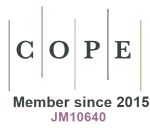Laboratory biomarkers of delayed cerebral ischemia following subarachnoid hemorrhage: A systematic review
DOI:
https://doi.org/10.33393/jcb.2023.2502Keywords:
Biomarker, Delayed cerebral ischemia, Subarachnoid hemorrhageAbstract
Delayed cerebral ischemia (DCI) substantially contributes to disability and death in subarachnoid hemorrhage (SAH) patients; however, its pathophysiology is incompletely understood and diagnostic and therapeutic strategies are lacking. Biomarkers may help to elucidate the pathophysiology, optimize early diagnosis, or provide treatment targets. We systematically searched PubMed and Embase on October 13, 2021, for studies that evaluated at least one laboratory biomarker in patients with DCI, using the most up-to-date definition of DCI as proposed by a panel of experts in 2010. Quality of studies was assessed using the Newcastle-Ottawa Scale or Cochrane Collaboration’s risk of bias assessment tool. Biomarkers of clinical and radiological DCI were analyzed separately. Results were meta-analyzed if possible, otherwise narratively reviewed. Biomarkers were classified as significant, inconclusive, or nonsignificant. We defined validated biomarkers as those with significant results in meta-analyses, or in at least two studies using similar methodologies within the same time interval after SAH. The search yielded 209 articles with 724 different biomarkers; 166 studies evaluated 646 biomarkers of clinical DCI, of which 141 were significant and 7 were validated biomarkers (haptoglobulin 2-1 and 2-2, ADAMTS13, vWF, NLR, P-selectin, F2-isoprostane); 78 studies evaluated 165 biomarkers of radiological DCI, of which 63 were significant and 1 was a validated biomarker (LPR). Hence, this review provides a selection of seven biomarkers of clinical DCI and one biomarker of radiological DCI as most promising biomarkers of DCI. Future research should focus on determining the exact predictive, diagnostic, and therapeutic potentials of these biomarkers.
References
- Dorhout Mees SM, Kerr RS, Rinkel GJ, Algra A, Molyneux AJ. Occurrence and impact of delayed cerebral ischemia after coiling and after clipping in the International Subarachnoid Aneurysm Trial (ISAT). J Neurol. 2012;259(4):679-683. https://doi.org/10.1007/s00415-011-6243-2 PMID:21947244 DOI: https://doi.org/10.1007/s00415-011-6243-2
- Macdonald RL. Delayed neurological deterioration after subarachnoid haemorrhage. Nat Rev Neurol. 2014;10(1):44-58. https://doi.org/10.1038/nrneurol.2013.246 PMID:24323051 DOI: https://doi.org/10.1038/nrneurol.2013.246
- Jabbarli R, Pierscianek D, Darkwah Oppong M, et al. Laboratory biomarkers of delayed cerebral ischemia after subarachnoid hemorrhage: a systematic review. Neurosurg Rev. 2018. 2020;43(3):825-833. https:// 10.1007/s10143-018-1037-y PMID:30306357 DOI: https://doi.org/10.1007/s10143-018-1037-y
- Vergouwen MD, Vermeulen M, van Gijn J, et al. Definition of delayed cerebral ischemia after aneurysmal subarachnoid hemorrhage as an outcome event in clinical trials and observational studies: proposal of a multidisciplinary research group. Stroke. 2010;41(10):2391-2395. https://doi.org/10.1161/STROKEAHA.110.589275 PMID:20798370 DOI: https://doi.org/10.1161/STROKEAHA.110.589275
- Petruk KC, West M, Mohr G, et al. Nimodipine treatment in poor-grade aneurysm patients. Results of a multicenter double-blind placebo-controlled trial. J Neurosurg. 1988;68(4):505-517. https://doi.org/10.3171/jns.1988.68.4.0505 PMID:3280746 DOI: https://doi.org/10.3171/jns.1988.68.4.0505
- Pickard JD, Murray GD, Illingworth R, et al. Effect of oral nimodipine on cerebral infarction and outcome after subarachnoid haemorrhage: British aneurysm nimodipine trial. BMJ. 1989;298(6674):636-642. https://doi.org/10.1136/bmj.298.6674.636 PMID:2496789 DOI: https://doi.org/10.1136/bmj.298.6674.636
- Budohoski KP, Guilfoyle M, Helmy A, et al. The pathophysiology and treatment of delayed cerebral ischaemia following subarachnoid haemorrhage. J Neurol Neurosurg Psychiatry. 2014;85(12):1343-1353. https://doi.org/10.1136/jnnp-2014-307711 PMID:24847164 DOI: https://doi.org/10.1136/jnnp-2014-307711
- Kim BJ, Kim Y, Kim SE, Jeon JP. Study of correlation between Hp α1 expression of haptoglobin 2-1 and clinical course in aneurysmal subarachnoid hemorrhage. World Neurosurg. 2018;117:e221-e227. https://doi.org/10.1016/j.wneu.2018.06.003 PMID:29902601 DOI: https://doi.org/10.1016/j.wneu.2018.06.003
- Leclerc JL, Blackburn S, Neal D, et al. Haptoglobin phenotype predicts the development of focal and global cerebral vasospasm and may influence outcomes after aneurysmal subarachnoid hemorrhage. Proc Natl Acad Sci USA. 2015;112(4):1155-1160. https://doi.org/10.1073/pnas.1412833112 PMID:25583472 DOI: https://doi.org/10.1073/pnas.1412833112
- Ohnishi H, Iihara K, Kaku Y, et al. Haptoglobin phenotype predicts cerebral vasospasm and clinical deterioration after aneurysmal subarachnoid hemorrhage. J Stroke Cerebrovasc Dis. 2013;22(4):520-526. https://doi.org/10.1016/j.jstrokecerebrovasdis.2013.02.005 PMID:23498376 DOI: https://doi.org/10.1016/j.jstrokecerebrovasdis.2013.02.005
- Li WH, Hui CJ, Ju H. Expression and significance of vWF, GMP-140 and ADAMTS13 in patients with aneurysmal subarachnoid hemorrhage. Eur Rev Med Pharmacol Sci. 2017;21(19):4350-4356. PMID:29077161
- Tang Q-F, Lu S-Q, Zhao Y-M, Qian J-X. The changes of von willebrand factor/a disintegrin-like and metalloprotease with thrombospondin type I repeats-13 balance in aneurysmal subarachnoid hemorrhage. Int J Clin Exp Med. 2015;8(1):1342-1348. PMID:25785135
- Liu H, Xu Q, Li A. Nomogram for predicting delayed cerebral ischemia after aneurysmal subarachnoid hemorrhage in the Chinese population. J Stroke Cerebrovasc Dis. 2020;29(9):105005. https://doi.org/10.1016/j.jstrokecerebrovasdis.2020.105005 PMID:32807421 DOI: https://doi.org/10.1016/j.jstrokecerebrovasdis.2020.105005
- Al-Mufti F, Amuluru K, Damodara N, et al. Admission neutrophil-lymphocyte ratio predicts delayed cerebral ischemia following aneurysmal subarachnoid hemorrhage. J Neurointerv Surg. 2019;11(11):1135-1140. https://doi.org/10.1136/neurintsurg-2019-014759 PMID:30979846 DOI: https://doi.org/10.1136/neurintsurg-2019-014759
- Tao C, Wang J, Hu X, Ma J, Li H, You C. Clinical value of neutrophil to lymphocyte and platelet to lymphocyte ratio after aneurysmal subarachnoid hemorrhage. Neurocrit Care. 2017;26(3):393-401. https://doi.org/10.1007/s12028-016-0332-0 PMID:28028791 DOI: https://doi.org/10.1007/s12028-016-0332-0
- Wu Y, He Q, Wei Y, et al. The association of neutrophil-to-lymphocyte ratio and delayed cerebral ischemia in patients with aneurysmal subarachnoid hemorrhage: possible involvement of cerebral blood perfusion. Neuropsychiatr Dis Treat. 2019;15:1001-1007. https://doi.org/10.2147/NDT.S190477 PMID:31118639 DOI: https://doi.org/10.2147/NDT.S190477
- Wang HC, Lin WC, Yang TM, et al. The association between symptomatic delayed cerebral infarction and serum adhesion molecules in aneurysmal subarachnoid hemorrhage. Neurosurgery. 2011;68(6):1611-1617. https://doi.org/10.1227/NEU.0b013e318210c871 PMID:21336217 DOI: https://doi.org/10.1227/NEU.0b013e318210c871
- Frijns CJ, Fijnheer R, Algra A, van Mourik JA, van Gijn J, Rinkel GJ. Early circulating levels of endothelial cell activation markers in aneurysmal subarachnoid haemorrhage: associations with cerebral ischaemic events and outcome. J Neurol Neurosurg Psychiatry. 2006;77(1):77-83. https://doi.org/10.1136/jnnp.2005.064956 PMID:16361599 DOI: https://doi.org/10.1136/jnnp.2005.064956
- Wiśniewski K, Popęda M, Tomasik B, et al. The role of urine F2-isoprostane concentration in delayed cerebral ischemia after aneurysmal subarachnoid haemorrhage—a poor prognostic factor. Diagnostics (Basel). 2020;11(1):22. https://doi.org/10.3390/diagnostics11010005 PMID:33375060 DOI: https://doi.org/10.3390/diagnostics11010005
- Wiśniewski K, Bieńkowski M, Tomasik B, et al. Urinary F2-isoprostane concentration as a poor prognostic factor after subarachnoid hemorrhage. World Neurosurg. 2017;107:185-193. https://doi.org/10.1016/j.wneu.2017.07.145 PMID:28782688 DOI: https://doi.org/10.1016/j.wneu.2017.07.145
- McGirt MJ, Blessing R, Nimjee SM, et al. Correlation of serum brain natriuretic peptide with hyponatremia and delayed ischemic neurological deficits after subarachnoid hemorrhage. Neurosurgery. 2004;54(6):1369-1373. https://doi.org/10.1227/01.NEU.0000125016.37332.50PMID:15157293 DOI: https://doi.org/10.1227/01.NEU.0000125016.37332.50
- Nakatsuka Y, Shiba M, Nishikawa H, et al; pSEED group. Acute-phase plasma osteopontin as an independent predictor for poor outcome after aneurysmal subarachnoid hemorrhage. Mol Neurobiol. 2018;55(8):6841-6849. https://doi.org/10.1007/s12035-018-0893-3 PMID:29353454 DOI: https://doi.org/10.1007/s12035-018-0893-3
- Suzuki H, Nakatsuka Y, Yasuda R, et al. Dose-dependent inhibitory effects of cilostazol on delayed cerebral infarction after aneurysmal subarachnoid hemorrhage. Transl Stroke Res. 2018;10(4):381-388. https:// 10.1007/s12975-018-0650-y PMID:30033486 DOI: https://doi.org/10.1007/s12975-018-0650-y
- Zhang X, Liu Y, Zhang S, Wang C, Zou C, Li A. Neutrophil-to-albumin ratio as a biomarker of delayed cerebral ischemia after aneurysmal subarachnoid hemorrhage. World Neurosurg. 2021;147:e453-e458. https://doi.org/10.1016/j.wneu.2020.12.084 PMID:33373740 DOI: https://doi.org/10.1016/j.wneu.2020.12.084
- Starke RM, Kim GH, Komotar RJ, et al. Endothelial nitric oxide synthase gene single-nucleotide polymorphism predicts cerebral vasospasm after aneurysmal subarachnoid hemorrhage. J Cereb Blood Flow Metab. 2008;28(6):1204-1211. https://doi.org/10.1038/jcbfm.2008.11 PMID:18319732 DOI: https://doi.org/10.1038/jcbfm.2008.11
- Kofler M, Gaasch M, Rass V, et al. The importance of probe location for the interpretation of cerebral microdialysis data in subarachnoid hemorrhage patients. Neurocrit Care. 2020;32(1):135-144. https://doi.org/10.1007/s12028-019-00713-8 PMID:31037640 DOI: https://doi.org/10.1007/s12028-019-00713-8
- Torné R, Culebras D, Sanchez-Etayo G, et al. Double hemispheric microdialysis study in poor-grade SAH patients. Sci Rep. 2020;10(1):7466. https://doi.org/10.1038/s41598-020-64543-xPMID:32366972 DOI: https://doi.org/10.1038/s41598-020-64543-x
- Yang TM, Lin YJ, Tsai NW, et al. The prognostic value of serial leukocyte adhesion molecules in post-aneurysmal subarachnoid hemorrhage. Clin Chim Acta. 2012;413(3-4):411-416. https://doi.org/10.1016/j.cca.2011.10.007 PMID:22074931 DOI: https://doi.org/10.1016/j.cca.2011.10.007
- Dodd WS, Laurent D, Dumont AS, et al. Pathophysiology of delayed cerebral ischemia after subarachnoid hemorrhage: a review. J Am Heart Assoc. 2021;10(15):e021845. https://doi.org/10.1161/JAHA.121.021845 PMID:34325514 DOI: https://doi.org/10.1161/JAHA.121.021845
- Yilmaz G, Granger DN. Cell adhesion molecules and ischemic stroke. Neurol Res. 2008;30(8):783-793. https://doi.org/10.1179/174313208X341085 PMID:18826804 DOI: https://doi.org/10.1179/174313208X341085
- Stähli BE, Gebhard C, Duchatelle V, et al. Effects of the P-selectin antagonist inclacumab on myocardial damage after percutaneous coronary intervention according to timing of infusion: insights from the SELECT-ACS trial. J Am Heart Assoc. 2016;5(11):e004255. https://doi.org/10.1161/JAHA.116.004255 PMID:27852589 DOI: https://doi.org/10.1161/JAHA.116.004255
- Griffiths S, Clark J, Adamides AA, Ziogas J. The role of haptoglobin and hemopexin in the prevention of delayed cerebral ischaemia after aneurysmal subarachnoid haemorrhage: a review of current literature. Neurosurg Rev. 2020;43(5):1273-1288. https://doi.org/10.1007/s10143-019-01169-2 PMID:31493061 DOI: https://doi.org/10.1007/s10143-019-01169-2
- Schmidt JM, Wartenberg KE, Fernandez A, et al. Frequency and clinical impact of asymptomatic cerebral infarction due to vasospasm after subarachnoid hemorrhage. J Neurosurg. 2008;109(6):1052-1059. https://doi.org/10.3171/JNS.2008.109.12.1052 PMID:19035719 DOI: https://doi.org/10.3171/JNS.2008.109.12.1052
- Kreiter KT, Mayer SA, Howard G, et al. Sample size estimates for clinical trials of vasospasm in subarachnoid hemorrhage. Stroke. 2009;40(7):2362-2367. https://doi.org/10.1161/STROKEAHA.109.547331 PMID:19461029 DOI: https://doi.org/10.1161/STROKEAHA.109.547331
- Frontera JA, Fernandez A, Schmidt JM, et al. Defining vasospasm after subarachnoid hemorrhage: what is the most clinically relevant definition? Stroke. 2009;40(6):1963-1968. https://doi.org/10.1161/STROKEAHA.108.544700 PMID:19359629 DOI: https://doi.org/10.1161/STROKEAHA.108.544700
- Frijns CJ, Kasius KM, Algra A, Fijnheer R, Rinkel GJ. Endothelial cell activation markers and delayed cerebral ischaemia in patients with subarachnoid haemorrhage. J Neurol Neurosurg Psychiatry. 2006;77(7):863-867. https://doi.org/10.1136/jnnp.2005.081539 PMID:16574731 DOI: https://doi.org/10.1136/jnnp.2005.081539










